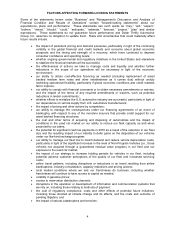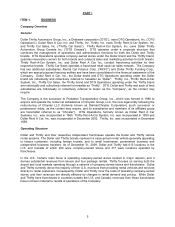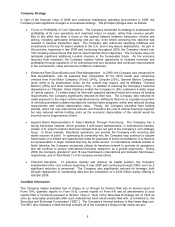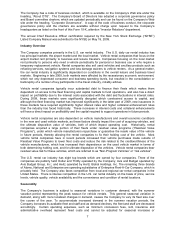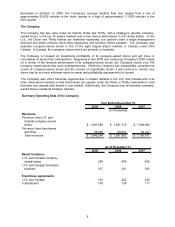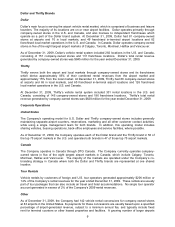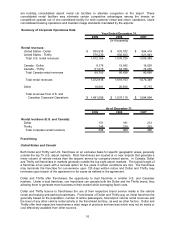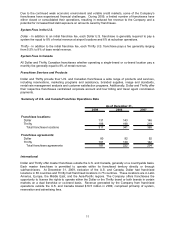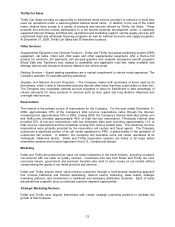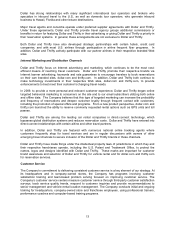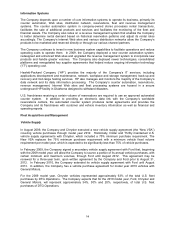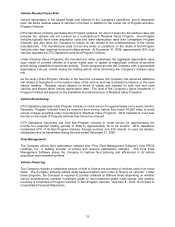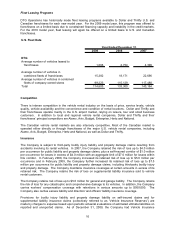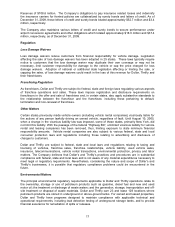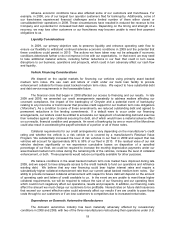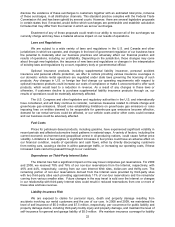Thrifty Car Rental 2009 Annual Report Download - page 15
Download and view the complete annual report
Please find page 15 of the 2009 Thrifty Car Rental annual report below. You can navigate through the pages in the report by either clicking on the pages listed below, or by using the keyword search tool below to find specific information within the annual report.Information Systems
The Company depends upon a number of core information systems to operate its business, primarily its
counter automation, Web sites, distribution network, reservations, fleet and revenue management
systems. The counter automation system in company-owned stores processes rental transactions,
facilitates the sale of additional products and services and facilitates the monitoring of the fleet and
financial assets. The Company also relies on a revenue management system that enables the Company
to better determine rental demand based on historical reservation patterns and adjust its rental rates
accordingly. The Company’s Internet Web sites and various distribution networks allow the Company’s
products to be marketed and reserved directly or through our various channel partners.
The Company continues to invest in new business system capabilities to facilitate operations and reduce
operating costs to operate them. In 2009, the Company deployed a new counter automation system,
redesigned and enhanced Web sites and upgraded the revenue management system to incorporate new
products and handle greater volumes. The Company also deployed newer technologies, consolidated
platforms and renegotiated key supplier agreements that helped reduce ongoing information technology
(“IT”) operating cost.
Hewlett-Packard Company (“HP”) provides the majority of the Company’s IT services, including
applications development and maintenance, network, workplace and storage management, back-up and
recovery and mid-range hosting services. HP also manages and monitors the majority of the Company’s
data network and its daily information processing. The Company’s counter automation, reservations,
revenue management, Internet Web sites and fleet processing systems are housed in a secure
underground HP facility in Oklahoma designed to withstand disasters.
U.S. franchisees receiving a certain volume of reservations are required to use an approved automated
counter system. In addition to providing an electronic data link with the Company’s worldwide
reservations centers, the automated counter system produces rental agreements and provides the
Company and its franchisees with customer and vehicle inventory information as well as financial and
operating reports.
Fleet Acquisition and Management
Vehicle Supply
In August 2009, the Company and Chrysler executed a new vehicle supply agreement (the “New VSA”)
covering vehicle purchases through model year 2012. Historically, Dollar and Thrifty maintained U.S.
vehicle supply agreements with Chrysler, which included a 75% minimum purchase requirement. The
New VSA replaces the 75% minimum purchase requirement with a minimum vehicle fixed volume
requirement per model year, which is expected to be significantly less than 75% of vehicle purchases.
In February 2009, the Company signed a secondary vehicle supply agreement with Ford that, beginning
with the 2009 model year, will allow the Company to source a portion of its annual vehicle purchases, with
certain minimum and maximum volumes, through Ford until August 2012. This agreement may be
renewed for a three-year term, upon written agreement by the Company and Ford prior to August 31,
2012. In February 2010, the Company extended its vehicle supply agreement with Ford until August
2013. In addition, the Company has a vehicle purchase agreement for model year 2010 vehicles with
General Motors.
For the 2009 model year, Chrysler vehicles represented approximately 63% of the total U.S. fleet
purchases by DTG Operations. The Company expects that for the 2010 model year, Ford, Chrysler and
General Motors, will represent approximately 34%, 30% and 20%, respectively, of total U.S. fleet
purchases of DTG Operations.
14


